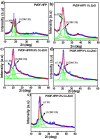Stretchable Electrospun PVDF-HFP/Co-ZnO Nanofibers as Piezoelectric Nanogenerators
- PMID: 29335498
- PMCID: PMC5768784
- DOI: 10.1038/s41598-017-19082-3
Stretchable Electrospun PVDF-HFP/Co-ZnO Nanofibers as Piezoelectric Nanogenerators
Erratum in
-
Author Correction: Stretchable Electrospun PVDF-HFP/Co-ZnO Nanofibers as Piezoelectric Nanogenerators.Sci Rep. 2019 Dec 19;9(1):19813. doi: 10.1038/s41598-019-56281-6. Sci Rep. 2019. PMID: 31852996 Free PMC article.
Abstract
Herein, we investigate the morphology, structure and piezoelectric performances of neat polyvinylidene fluoride hexafluoropropylene (PVDF-HFP) and PVDF-HFP/Co-ZnO nanofibers, fabricated by electrospinning. An increase in the amount of crystalline β-phase of PVDF-HFP has been observed with the increase in Co-doped ZnO nanofiller concentration in the PVDF-HFP matrix. The dielectric constants of the neat PVDF-HFP and PVDF-HFP/2 wt.% Co-ZnO nanofibers are derived as 8 and 38 respectively. The flexible nanogenerator manipulated from the polymer nanocomposite (PVDF-HFP/Co-ZnO) exhibits an output voltage as high as 2.8 V compared with the neat PVDF-HFP sample (~120 mV). These results indicate that the investigated nanocomposite is appropriate for fabricating various flexible and wearable self-powered electrical devices and systems.
Conflict of interest statement
The authors declare that they have no competing interests.
Figures










Similar articles
-
Core-Shell Nanofibers of Polyvinylidene Fluoride-based Nanocomposites as Piezoelectric Nanogenerators.Polymers (Basel). 2020 Oct 13;12(10):2344. doi: 10.3390/polym12102344. Polymers (Basel). 2020. PMID: 33066181 Free PMC article.
-
ZnO/PVDF Nanogenerators with Hemisphere-Patterned PDMS for Enhanced Piezoelectric Performance.Polymers (Basel). 2025 Jul 26;17(15):2041. doi: 10.3390/polym17152041. Polymers (Basel). 2025. PMID: 40808090 Free PMC article.
-
Investigation on the effect of γ-irradiation on the dielectric and piezoelectric properties of stretchable PVDF/Fe-ZnO nanocomposites for self-powering devices.Soft Matter. 2018 Nov 7;14(43):8803-8813. doi: 10.1039/c8sm01655k. Soft Matter. 2018. PMID: 30345447
-
Stretchable piezoelectric nanocomposite generator.Nano Converg. 2016;3(1):12. doi: 10.1186/s40580-016-0072-z. Epub 2016 Jun 3. Nano Converg. 2016. PMID: 28191422 Free PMC article. Review.
-
Advancements in Flexible Nanogenerators: Polyvinylidene Fluoride-Based Nanofiber Utilizing Electrospinning.Molecules. 2024 Jul 29;29(15):3576. doi: 10.3390/molecules29153576. Molecules. 2024. PMID: 39124980 Free PMC article. Review.
Cited by
-
Flexible piezoelectric materials and strain sensors for wearable electronics and artificial intelligence applications.Chem Sci. 2024 Sep 27;15(40):16436-66. doi: 10.1039/d4sc05166a. Online ahead of print. Chem Sci. 2024. PMID: 39355228 Free PMC article. Review.
-
Core-Shell Nanofibers of Polyvinylidene Fluoride-based Nanocomposites as Piezoelectric Nanogenerators.Polymers (Basel). 2020 Oct 13;12(10):2344. doi: 10.3390/polym12102344. Polymers (Basel). 2020. PMID: 33066181 Free PMC article.
-
Toward High Power Generating Piezoelectric Nanofibers: Influence of Particle Size and Surface Electrostatic Interaction of Ce-Fe2O3 and Ce-Co3O4 on PVDF.ACS Omega. 2019 Apr 4;4(4):6312-6323. doi: 10.1021/acsomega.9b00243. eCollection 2019 Apr 30. ACS Omega. 2019. PMID: 31459771 Free PMC article.
-
In vitro and in vivo studies on the biocompatibility of a self-powered pacemaker with a flexible buckling piezoelectric vibration energy harvester for rats.Ann Transl Med. 2021 May;9(9):800. doi: 10.21037/atm-21-1707. Ann Transl Med. 2021. PMID: 34268413 Free PMC article.
-
Correlating the Macrostructural Variations of an Ion Gel with Its Carbon Dioxide Sorption Capacity.Membranes (Basel). 2022 Nov 1;12(11):1087. doi: 10.3390/membranes12111087. Membranes (Basel). 2022. PMID: 36363642 Free PMC article.
References
-
- Tabachnyk M, Ehrler B, Bayliss S, Friend RH, Greenham NC. Triplet diffusion in singlet exciton fission sensitized pentacene solar cells. Appl. Phys. Lett. 2013;103(5):153302–153304.
-
- Saravanakumar B, Mohan R, Thiyagarajan K, Kim SJ. Fabrication of a ZnO nanogenerator for eco-friendly biomechanical energy harvesting. RSC Adv. 2013;3:16646–16656.
-
- Lin ZH, et al. BaTiO3 nanotubes- based flexible and transparent nanogenerators. J. Phys. Chem. Lett. 2012;3:3599–3604. - PubMed
-
- Park KI, Jeong CK, Ryu J, Hwang GT, Lee KJ. Flexible and large-area nanocomposite generators based on lead zirconate titanate particles and carbon nanotubes. Adv. Energy Mater. 2013;3:1539–1544.
-
- Alam MM, Ghosh SK, Sultana A, Mandal D. Lead-free ZnSnO3/MWCNTs-based self-poled flexible hybrid nanogenerator for piezoelectric power generation. Nanotechnology. 2015;26:165403. - PubMed
Publication types
LinkOut - more resources
Full Text Sources
Other Literature Sources

